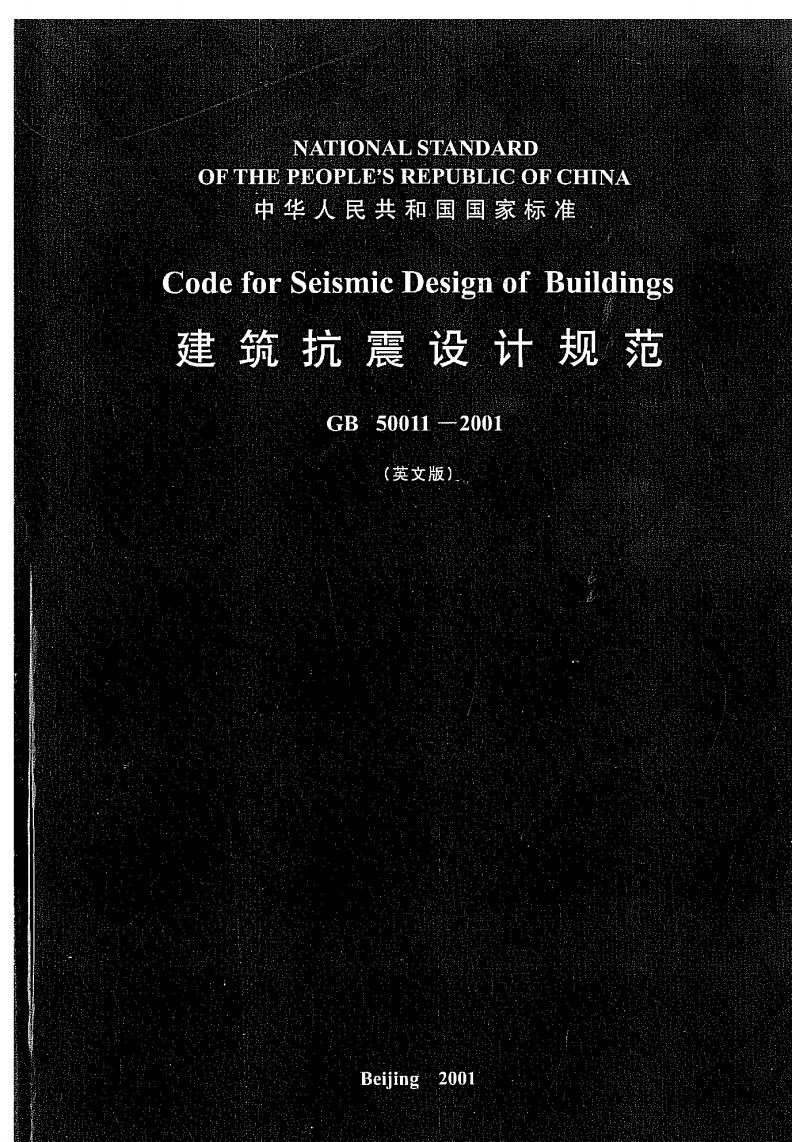
NATIONAL STANDARD OF THE PEOPLE'S REPUBLIC OF CHINA 中华人民共和国国家标准 Code for Seismic Design of Buildings 建筑抗震设计规范 GB50011-2001 (英文版) Beijing 2001
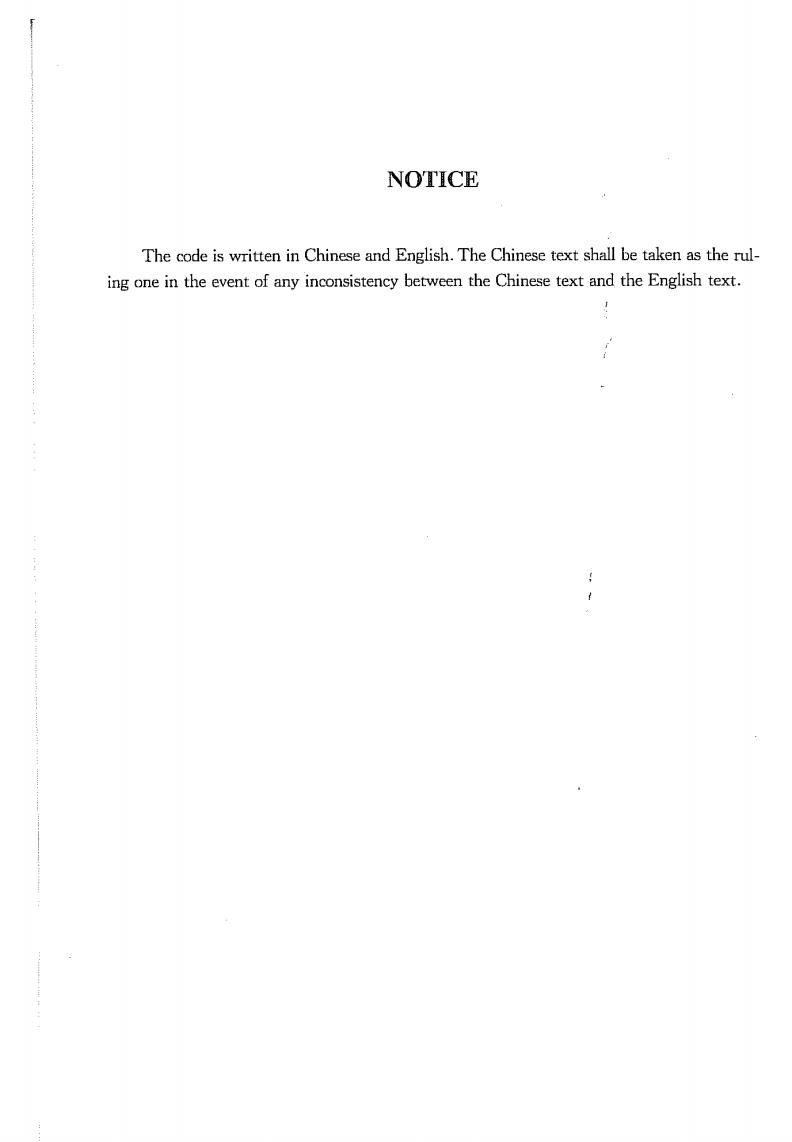
NOTICE The code is written in Chinese and English.The Chinese text shall be taken as the rul ing one in the event of any inconsistency between the Chinese text and the English text

Notice of Promulgation for the National Standard “Code for Seismic Design of Buildings'” Document JB[2001]No.156 According to the requirements of "Notice of Printing and Distributing for the1997 Preparation and Revision Plan of Engineering Construction Standards'(Document JB[1997] No.108)-Ministry of Construction",that the"Code for Seismic Design of Buildings"has been revised by Ministry of Construction together with the relevant departments,after a joint examination of relevant departments,hence the new code has been approved as a na- tional standard with a serial number of GB50011-2001,and it shall come into force upon January1,2002.Herein,clauses1.0.2,1.0.4,3.1.1,3.1.3,3.3.1,3.3.2,3.4.1, 3.5.2,3.7.1,3.8.1,3.9.1,3.9.2,4.1.6,4.1.9,4.2.2,4.3.2,4.4.5,5.1.1, 5.1.3,5.1.4,5.1.6,5.2.5,5.4.1,5.4.2,6.1.2,6.3.3,6.3.8,6.4.3,7.1.2, 7.1.5,7.1.8,7.2.4,7.2.7,7.3.1,7.3.3,7.3.5,7.4.1,7.4.4,7.5.3,7.5.4 8.1.3,8.3.1,8.3.6,8.4.2,8.5.1,10.1.3,10.2.5,10.3.3,12.1.2,12.1.5 12.2.1 and 12.2.9 are compulsory provisions,which must be enforced strictly.The former "Code for Seismic Design of Buildings"GBJ 11-89 and the"Proclamation on Partial Revi- sion for National Standards of Engineering Construction"(No.1)shall be abolished after De- cember 31,2002 The Ministry of Construction is in charge of management and explanation of the mandatory clauses in the code,the China Academy of Building Research will be responsible for the explanation of specific technical contents and the Research Institute of Standards and Norms-Ministry of Construction will organize the China Architecture Building Press to take on publishing and distributing works of this code. Ministry of Construction of the People's Republic of China July20,2001

PREFACE The present code is the revised version of the former "Code for seismic design of build- ings"GBJ 11-89.The revision is undertaken by China Academy of Building Research (CABR)together with other institutions related to design,reconnaissance,research,and universities in accordance with the Document JB [1997]No.108 issued by the Ministry of Construction. During the process of revision,the editorial team carried out studies on specific topics and some laboratory tests concerned.Experiences and lessons,learned from damages in- duced by strong earthquake having occurred in recent years home and abroad,are summa rized,achievements of research in earthquake engineering are involved,the economic condi- tion and construction practices in China are taken into account,comments from all aspects of design,reconnaissance,research,education and municipal authorities are widely collected nation wide.Through a multi-round discussion,revision,substantiation,and with pilot de- signs as well,the final version has been completed and reviewed by an expert panel The newly updated version consists of 13 chapters and 11 appendixes.The major con- tents of the revision can be clarified by follows:the seismic fortification classification for buildings has been adjusted;the seismic design is required to be based on the design basic ac- celeration of the ground motion:the near-field and far-field earthquakes employed by the previous code have been replaced by the design earthquake groups;provisions related to the site classification,liquefaction identification,seismic influence coefficient and torsion effect calculation have been modified;requirements for the conception design of irregular building structures,the seismic analysis of structures,the limit of inter-story seismic shear force and deformation have been added;the seismic measures of masonry and concrete structures,and masonry buildings with bottom R.C.frames have been improved;more contents related to active fracture,pile foundation,R.C.tube structure,steel structure,reinforced hollow block masonry structure,and non-structural components,as well as the provisions for bas isolation and energy dissipation have been involved.In the meantime,the new code has ab- rogated some provisions dealing with inner-frame house and medium-sized block masonry structure,chimney and water tower,etc. The new code could be partly modified in the future.The relevant information and de- tails ofwill be published on the mg tion" Clauses marked with boldface type in this code are compulsory provisions and must be enforced strictly. The Institute of Earthquake Engineering of CABR is responsible for the interpretation of this code.Hopefully,in the process of its enforcement,all institutions may sum up and
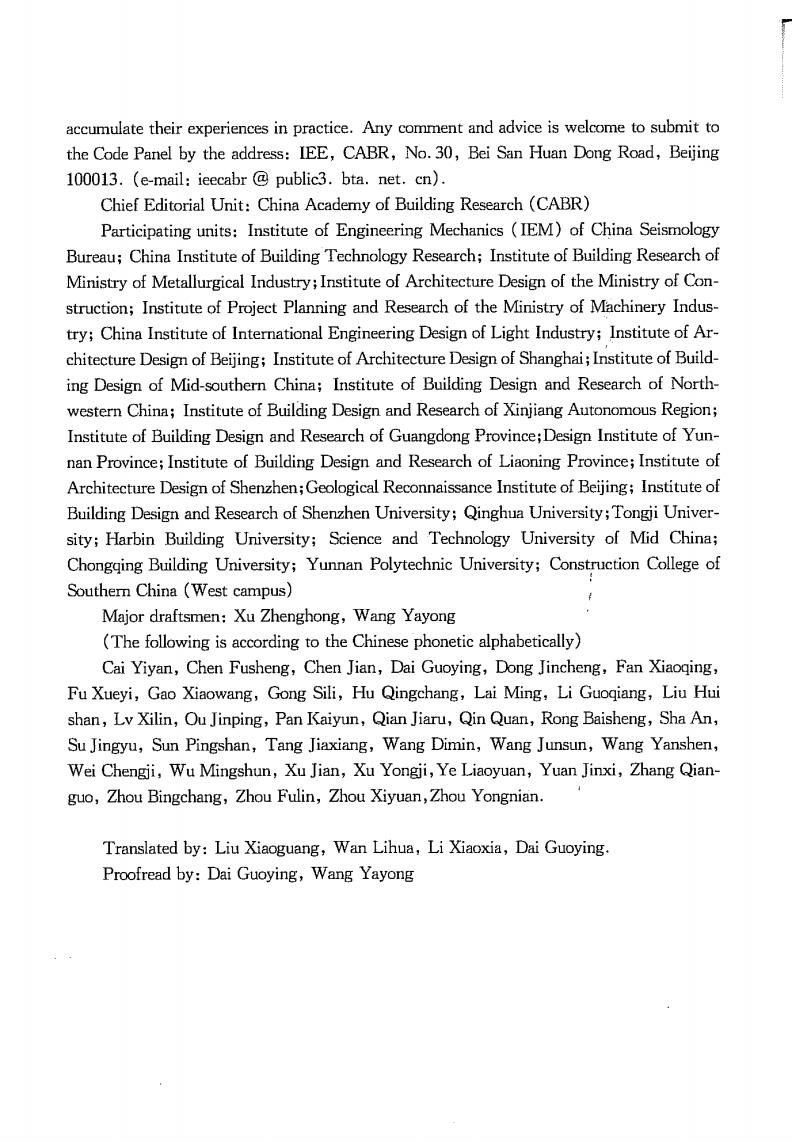
accumulate their experiences in practice.Any comment and advice is welcome to submit to the Code Panel by the address:IEE,CABR,No.30,Bei San Huan Dong Road,Beijing 100013.(e-mail:ieecabr public3.bta.net.cn). Chief Editorial Unit:China Academy of Building Research(CABR) Participating units:Institute of Engineering Mechanics (IEM)of China Seismology Bureau;China Institute of Building Technology Research;Institute of Building Research of Ministry of Metallurgical Industry;Institute of Architecture Design of the Ministry of Con- struction;Institute of Project Planning and Research of the Ministry of Machinery Indus- try;China Institute of International Engineering Design of Light Industry;Institute of Ar- chitecture Design of Beijing:Institute of Architecture Design of Shanghai;Institute of Build. ing Design of Mid-southern China;Institute of Building Design and Research of North western China;Institute of Building Design and Research of Xinjiang Autonomous Region; Institute of Building Design and Research of Guangdong Province;Design Institute of Yun nan Province;Institute of Building Design and Research of Liaoning Province;Institute of Architecture Design of Shenzhen;Geological Reconnaissance Institute of Beijing;Institute of Building Design and Research of Shenzhen University;Qinghua University;Tongji Univer- sity;Harbin Building University:Science and Technology University of Mid China Chongging Building University;Yunnan Polytechnic University;Construction College of Southern China (West campus) Major draftsmen:Xu Zhenghong,Wang Yayong (The following is according to the Chinese phonetic alphabetically) Cai Yiyan,Chen Fusheng,Chen Jian,Dai Guoying,Dong Jincheng,Fan Xiaoqing, Fu Xueyi,Gao Xiaowang,Gong Sili,Hu Qingchang,Lai Ming,Li Guoqiang,Liu Hui shan,Lv Xilin,Ou Jinping,Pan Kaiyun,Qian Jiaru,Qin Quan,Rong Baisheng,Sha An, Su Jingyu,Sun Pingshan,Tang Jiaxiang,Wang Dimin,Wang Junsun,Wang Yanshen, Wei Chengji,Wu Mingshun,Xu Jian,Xu Yongji,Ye Liaoyuan,Yuan Jinxi,Zhang Qian- guo,Zhou Bingchang,Zhou Fulin,Zhou Xiyuan,Zhou Yongnian. Translated by:Liu Xiaoguang,Wan Lihua,Li Xiaoxia,Dai Guoying Proofread by:Dai Guoying,Wang Yayong
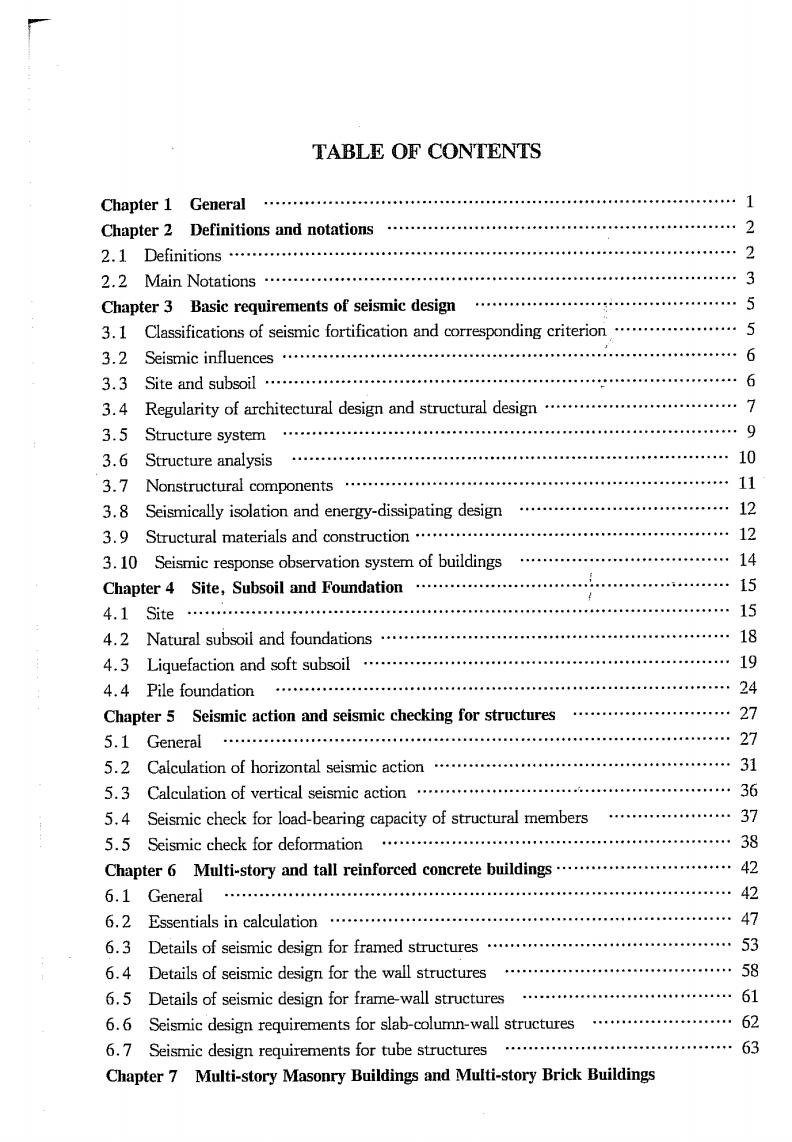
TABLE OF CONTENTS Chapter 1 General 44444t………4…4t44**01 Chapter 2 Definitions and notations...2 2.1 Definitions 2 2.2 Main Notations…3 Chapter 3 Basic requirements of seismic 3.1 Classifications of seismic fortification and corresponding 3.2 Seismic influences…6 3.3 Site and subsoil.................... 6 3.4 Regularity of architectural design and structural 3.5 Structure system..................9 3.6 Structure analysis …10 3.7 Nonstructural components 3.8 Seismically isolation and energy-dissipating design..12 3.9 Structural materials and 3.10 Seismic response observation system of buildings......14 Chapter4Site,Subsoil and Foundation…s… 15 4.1 Site 4.2 Natural subsoil and foundations......................18 4.3 Liquefaction and soft subsoil... 19 4.4 Pile foundation Chapter 5 Seismic action and seismic checking for structures.....27 5.1 General… …27 5.2 Calculation of horizontal seismic action 3 5.3 Calculation of vertical seismic action.......36 5.4 Seismic check for load-bearing capacity of structural members ,37 5.5 Seismic check for deformation.38 Chapter 6 Multi-story and tall reinforced concrete buildings..... 42 6.1 General 42 6.2 Essentials in calculation...............47 6.3 Details of seismic design for framed structures.. 53 6.4 Details of seismic design for the wall structures 6.5 Details of seismic design for frame-wall structures …449t4**0…61 6.6 Seismic design requirements for slab-column-wall structures 62 6.7 Seismic design requirements for tube structures Chapter 7 Multi-story Masonry Buildings and Multi-story Brick Buildings

with Bottom-frame or Inner-frame...................................65 7.1 General…65 7.2 Essentials in calculation................................................................69 7.3 Details of seismic design for multi-story clay brick buildings74 7.4 Details of seismic design for multi-story small-block buildings80 7.5 Details of seismic design for multi-story buildings with bottom-frame..82 7.6 Details of seismic design for multi-story buildings with inner-frames …84 Chapter 8 Multi-story and tall steel structure buildings............86 8.1 General…86 8.2 Essentials in calculation ..88 8.3 Details of seismic design for steel framed structures..........................94 8.4 Details of seismic design for steel frame-epicenter-braced structures 97 8.5 Details of seismic design for steel frame-eccentric-braced structures …99 Chapter 9 Single-story factory buildings....................102 9.1 single-story factory buildings with reinforced concrete columns...102 9.2 single-story steel structure factory 9.3 single-story factory buildings with brick columns...115 Chapter 10 Single-story spacious buildings 120 10.1 General…120 10.2 Essentials in calculation..120 10.3 Details of seismic design.....121 Chapter 11 Earth,wood and stone houses........................123 11.1 Unfired earth houses in villages and towns …123 11.2W0 od houses…124 11.3 Stone buildings....125 Chapter 12 Seismic-isolation and seismic-energy-dissipating design127 12.1…127 12.2 Essentials in design of seismic-isolation buildings............128 12.3 Essentials in design of scismic-energy-dissipated Chapter 13 Nonstructural components...38 13.1 Genere阳l…138 13.2 Basic requirements for calculation 138 13.3 Basic seismic-measures for architectural nonstructural members.141 13.4 Basic seismic-measures for the supports of mechanical and electrical …144 Appendix A The fortification intensity,design basic accelerations of ground motion and design earthquake groups of main cities and towns in China.146 Appendix B Requirements for seismic design of high strength grades concrete
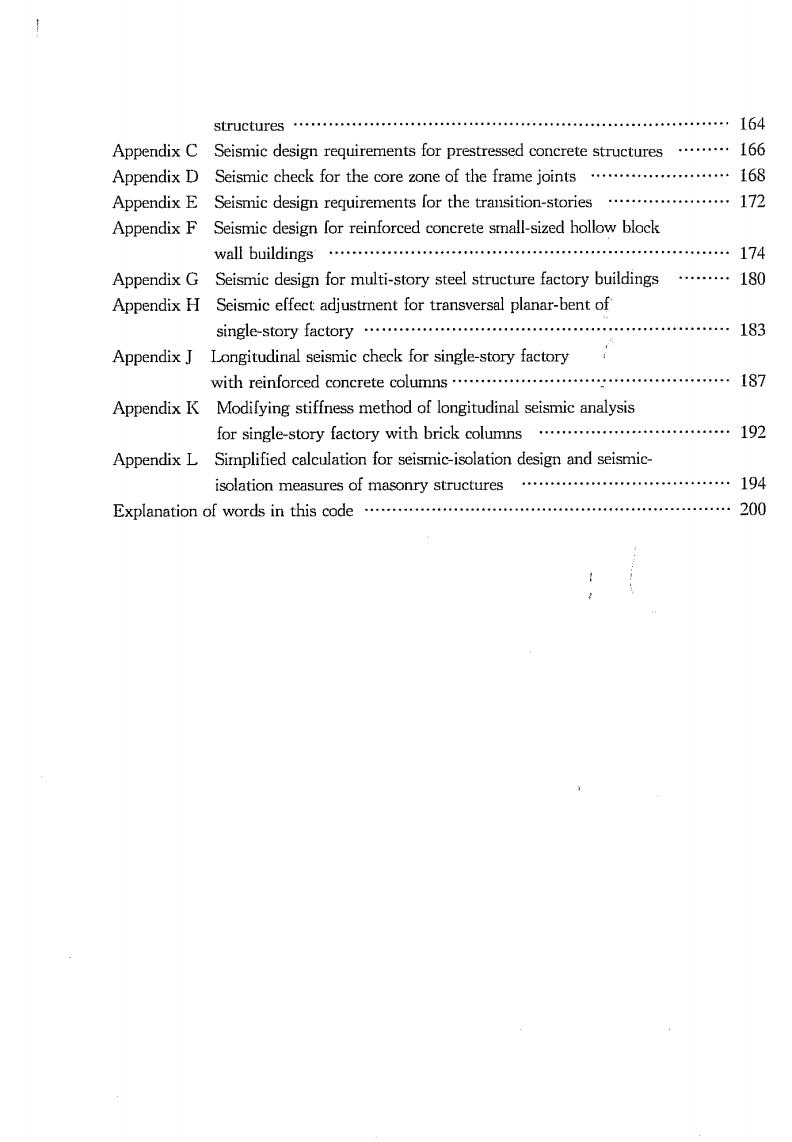
structures…164 Appendix C Seismic design requirements for prestressed concrete structures........166 Appendix D Seismic check for the core zone of the frame joints.168 Appendix E Seismic design requirements for the transition-stories 44*…4”】72 Appendix F Seismic design for reinforced concrete small-sized hollow block wall buildings …174 Appendix G Seismic design for multi-story steel structure factory buildings …180 Appendix H Seismic effect adjustment for transversal planar-bent of single-story factory… …183 Appendix J Longitudinal seismic check for single-story factory with reinforced concrete columns.. 187 Appendix K Modifying stiffness method of longitudinal seismic analysis for single-story factory with brick columns.............192 Appendix L Simplified calculation for seismic-isolation design and seismic isolation measures of masonry Explanation of words in this code …200
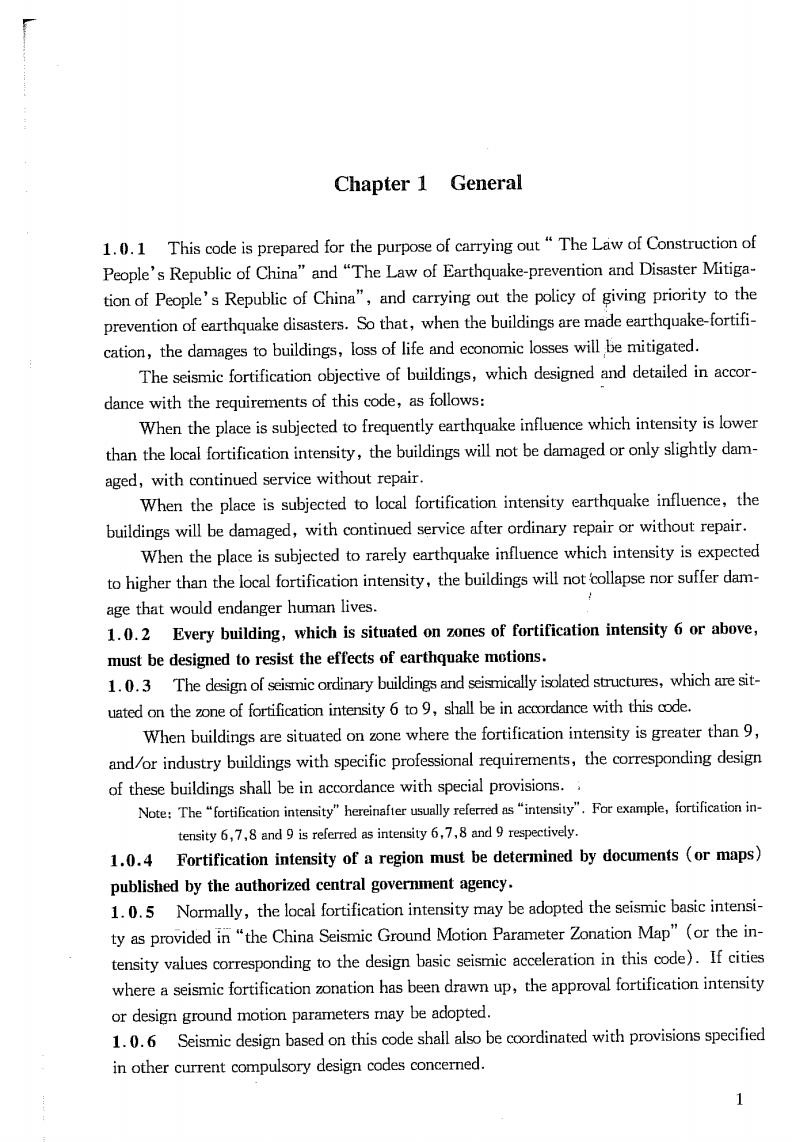
Chapter 1 General 1.0.1 This code is prepared for the purpose of carrying out"The Law of Construction of People's Republic of China"and "The Law of Earthquake-prevention and Disaster Mitiga- tion of People's Republic of China",and carrying out the policy of giving priority to the prevention of earthquake disasters.Sothat,when the buildings are made earthquake-fortifi- cation,the damages to buildings,loss of life and economic losses will be mitigated. The seismic fortification objective of buildings,which designed and detailed in accor- dance with the requirements of this code,as follows: When the place is subjected to frequently earthquake influence which intensity is lower than the local fortification intensity,the buildings will not be damaged or only slightly dam- aged,with continued service without repair. When the place is subjected to local fortification intensity earthquake influence,the buildings will be damaged,with continued service after ordinary repair or without repair. When the place is subjected to rarely earthquake influence which intensity is expected to higher than the local fortification intensity,the buildings will notllapse nor suffer dam age that would endanger human lives. 1.0.2 Every building,which is situated on zones of fortification intensity 6 or above, must be designed to resist the effects of earthquake motions 1.0.3 The designof scmcordinary buildings and seismically islated structures,which are sit- uated on the zone of fortification intensity 6to9,shall be in accordance with this code. When buildings are situated on zone where the fortification intensity is greater than 9, andor industry buildings with specific professional requirements,the corresponding design of these buildings shall be in accordance with special provisions.. Note:Theorficininesityhereinafer uslly reeredas"inteniFrxmpefortification in tensity6,78andis referrd as inesiy679reectively. 1.0.4 Fortification intensity of a region must be determined by documents (or maps) published by the authorized central government agency. 1.0.5 Normally,the local fortification intensity may be adopted the seismic basic intensi- ty as provided in"the China Seismic Ground Motion Parameter Zonation Map"(or the in- tensity values corresponding to the design basic seismic acceleration in this code).If cities where a seismic fortification zonation has been drawn up,the approval fortification intensity or design ground motion parameters may be adopted. 1.0.6 Seismic design based on this code shall also be coordinated with provisions specified in other current compulsory design codes concerned. 1
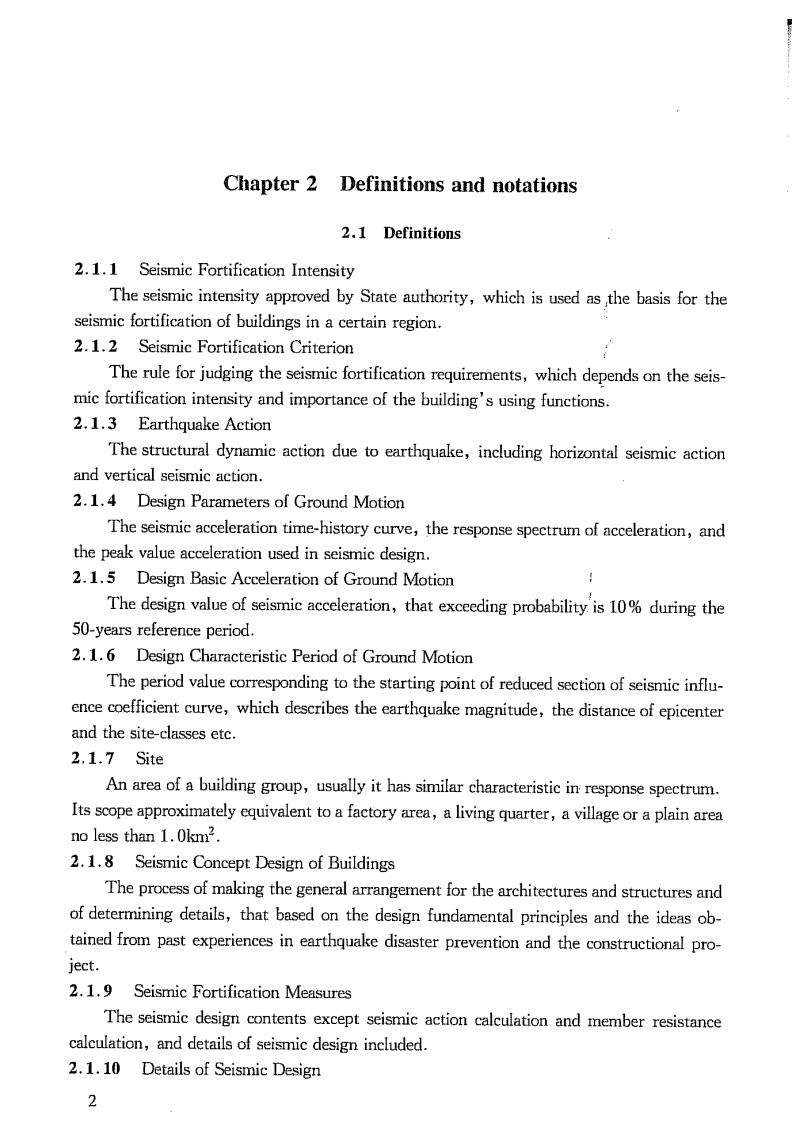
Chapter 2 Definitions and notations 2.1 Definitions 2.1.1 Seismic Fortification Intensity The seismic intensity approved by State authority,which is used as the basis for the seismic fortification of buildings in a certain region. 2.1.2 Seismic Fortification Criterion The rule for judging the seismic fortification requirements,which depends on the seis- micfneity and imranof the builings using functions. 2.1.3 Earthquake Action The structural dynamic action due to earthquake,including horizontal seismic action and vertical seismic action. 2.1.4 Design Parameters of Ground Motion The seismic acceleration time-history curve,the response spectrum of acceleration,and the peak value acceleration used in seismic design 2.1.5 Design Basic Acceleration of Ground Motion The design value of seismic acceleration,that exceeding probability is10%during the 50-years reference period. 2.1.6 Design Characteristic Period of Ground Motion The period value corresponding to the starting point of reduced section of seismic influ ence coefficient curve,which describes the earthquake magnitude,the distance of epicenter and the site-classes etc. 2.1.7 Site An area of a building group,usually it has similar characteristic in response spectrum. Its scope approximately equivalent to a factory area,a living quarter,a village or a plain area no less than 1.0km2 2.1.8 Seismic Concept Design of Buildings The process of making the general arrangement for the architectures and structures and of determining details,that based on the design fundamental principles and the ideas ob- tained from past experiences in earthquake disaster prevention and the constructional pro- ject. 2.1.9 Seismic Fortification Measures The seismic design contents except seismic action calculation and member resistance calculation,and details of seismic design included. 2.1.10 Details of Seismic Design 2